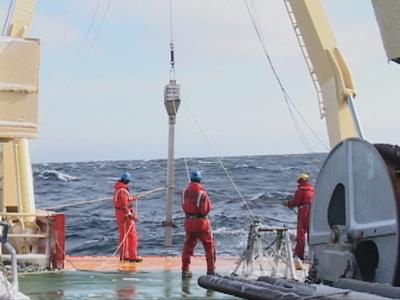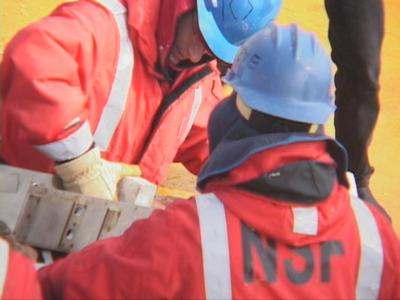
|
|
11 February, 2001
-66.29 lat 147.40 long
The Jumbo Piston Core (JPC) and the Kasten Core
There are two kinds of coring device: a Kasten core and a jumbo piston
core. The Kasten core is like a metal box with several hundred pounds of
weight on top. They deploy the Kasten core with a winch and wire off the
back of the ship Once deployed we watch the monitor to see when the core
reaches the ocean floor by the decrease in wire tension, displayed on the
screen. We then stop the winch and pull the core gently back out of the
sediment, and back up to the sea surface. The Kasten core is important for
sampling where the ocean floor meets the water. It is this "sediment water
interface" that tells us we have recovered the very top most surface of the
sediment. Often times this is lost when we use the jumbo piston core
(described next). Once the Kasten core is back on board, we make a
decision whether to deploy the jumbo piston core. It is quite an
operation; the piston core is an 80 foot steel pipe around an equal amount
of plastic PVC pipe. The PVC pipe, or liner, is just regular plastic four
inch drainpipe. The liner is cut into eight ten-foot sections, joined
together end to end inside the steel pipe. The core is deployed over the
side of the ship by winch and wire. As it approaches the sea floor, a
lever arm attached to the side of the piston core with a small weight on it
hits the bottom first, releasing a catch so that the jumbo piston core
free-falls and hits the bottom. With up to 4500 pounds of weight behind
it, the jumbo piston core hopefully sinks 80 feet down into the sediment.
Suction pulls the sediment up into the liner as the core pushes through it.
Why do we need suction* ? On the bottom of the piston core is a core
catcher, which stops the sediment from falling out as the core is withdrawn
from the floor. Once the core is at the sea surface again, we use a crane
to put it on the side of the deck railing. Then a hydraulic motor pushes
the liners out ten feet at a time. A "cap" is put on the ends of each
section, with labeling to indicate core top , bottom, and station number.
The individual core sections are then carried into the lab for processing
(processing next week). Lots of things have to work right, and lots of
things can go wrong (entries to follow). It is a very tense and nerve
wracking procedure, but so far we have had three successful cores up and on
board.
*so the sediment will go up into the tube




Contact the TEA in the field at
.
If you cannot connect through your browser, copy the
TEA's e-mail address in the "To:" line of
your favorite e-mail package.
|
